#Childcare Learning & documentation app
Explore tagged Tumblr posts
Text
Explore Xap Technologies' Free Childcare Apps for Seamless Daycare Sign In App and Childcare Learning & Documentation App
Managing a childcare facility can be complex, but with the right tools, you can make it simpler and more efficient. Xap Technologies offers a range of free childcare apps that will revolutionise how you manage your day care centre. Our daycare sign in app and Childcare Learning & Documentation App are designed to help improve operational efficiency and make learning documentation easier, all while saving you valuable time.

Our free childcare apps provide child care centres with user-friendly, effective solutions to everyday challenges. The daycare sign in app is a secure, digital system that ensures accurate attendance tracking. Parents can sign their children in and out quickly using their smartphones, reducing the need for paper-based records and cutting down on time-consuming administrative tasks. With automatic time logging and real-time updates, this app makes attendance management a breeze.
The Childcare Learning & Documentation App is another powerful tool for early learning educators. This app allows you to track children’s developmental milestones, learning progress, and daily activities in an easy-to-use digital format. Gone are the days of cumbersome paper logs—this app keeps all documentation organised and easily accessible, making it simpler for educators to share progress with parents and staff. With the ability to quickly record observations, you can ensure that every child’s development is accurately tracked and properly documented.
Whether you’re running a small daycare or a large childcare centre, these apps provide essential tools for day-to-day operations. The free childcare apps offered by Xap Technologies also include seamless integration, so you can manage everything from sign-ins to learning documentation without the hassle of juggling multiple systems.
Experience the convenience and efficiency of our daycare sign in app and Childcare Learning & Documentation App by signing up for a free trial today. Discover how these tools can streamline your processes and help provide better care and learning experiences for the children in your care. Try Xap Technologies now and see how we can transform your childcare centre!
Source
0 notes
Text
Change Your Future: The Ultimate Guide to Earning Your Online Associate Degree in Nursing
transform Your Future: The Ultimate Guide to Earning Your Online Associate Degree in nursing
Are you considering a career in nursing but don’t have the time for a customary classroom setting? An online Associate Degree in Nursing (ADN) could be the perfect solution for you! This guide will take you through everything you need to know to make the transition to a fulfilling nursing career while balancing your life and work commitments.
What is an Online Associate Degree in Nursing?
An online Associate Degree in nursing is a two-year program designed to equip you with the fundamental skills and knowlege needed to become a registered nurse (RN). While online, the program typically includes clinical training that must be completed in person at designated healthcare facilities.
Program Structure
Semester
Coursework
Clinical practice
1
Introduction to Nursing, Human Anatomy
Basic Clinical Skills
2
Pharmacology, Nursing Fundamentals
Patient Care Basics
3
Pediatrics, Mental Health Nursing
Childcare and Psychiatric care
4
Community Health, Advanced Nursing
Community health Settings
Benefits of Earning Your Online Associate Degree in Nursing
Adaptability: Study at your own pace from anywhere with an internet connection.
Cost-Effective: Online programs tend to have lower tuition fees compared to traditional on-campus programs.
In-Demand Career: Nursing is projected to grow by 7% over the next decade, providing numerous job opportunities.
work-Life Balance: Online learning allows you to manage your studies alongside work and personal commitments.
How to Choose the Right Online ADN Program
When you’re ready to select your program, consider the following factors:
Accreditation: Ensure the program is accredited by a recognized body, such as the Accreditation commission for Education in Nursing (ACEN).
Clinical Placement: Look for programs that assist with finding local clinical placements.
Student Support services: Research available resources such as tutoring, career counseling, and mentorship.
Program Reputation: Read reviews and talk to alumni about their experiences.
Practical tips for Success in an Online ADN Program
1. **create a Study Schedule:** Set aside dedicated time each week for classes, studying, and assignments. 2. **Stay Organized:** use tools like calendars or planning apps to track deadlines and clinical placements. 3. **Engage with Instructors and Peers:** Participate in online discussions and seek help when needed. 4. **Utilize Online Resources:** Take advantage of online libraries, videos, and study guides provided by your program. 5.**Practice Clinical Skills:** Use simulation apps or study groups to practice examination and treatment techniques.
Real-Life experiences: Case Studies of Triumphant Nurses
Many students have transformed their lives by earning their online Associate Degree in Nursing. Here are a couple of inspiring stories:
Maria’s Journey
Maria worked as a medical assistant for several years and wanted to advance her career. After enrolling in an online ADN program, she managed to balance work, school, and family life. Within two years, Maria graduated and secured a position in a local hospital, realizing her dream of becoming an RN.
David’s Conversion
David was initially apprehensive about returning to school as an adult. however, studying online allowed him the flexibility to continue his part-time job while studying.With determination and hard work,he not only graduated with his ADN but also was awarded the ‘Outstanding Student Nurse’ award by his faculty.
Steps to Getting Started
Ready to begin your journey? Follow these steps:
1. **Research Programs:** Utilize online resources to explore various ADN programs. 2. **Prepare required Documents:** Gather high school transcripts, letters of recommendation, and a personal statement. 3. **Complete the Submission:** Adhere to deadlines and ensure all documents are submitted. 4. **Plan Your Finances:** Explore financial aid,scholarships,and payment plans offered by the institution. 5. **Begin the Program:** Engage with course materials�� and connect with fellow students right from day one.
Conclusion
Earning your online Associate Degree in Nursing is more than just a stepping stone to becoming a registered nurse; it is a transformative journey that can open doors to a rewarding career. The flexibility, affordability, and countless opportunities make online nursing education an attractive choice for many aspiring nurses. With dedication and the right resources, you can achieve this important milestone and contribute positively to the healthcare field.
Embrace the opportunity to transform your future today by taking the first step towards your online ADN!
youtube
https://nursingcertificationcourses.com/change-your-future-the-ultimate-guide-to-earning-your-online-associate-degree-in-nursing/
0 notes
Text
Exploring Franchise Business Opportunities: Your Path to Entrepreneurship
Franchising offers a unique opportunity for aspiring entrepreneurs to own a business backed by a proven model, established brand, and ongoing support. If you’re considering diving into the world of franchising, here’s a guide to the most exciting franchise opportunities in 2025 and tips to find the right fit for you.
Why Franchising? : Franchise Business Opportunities
Franchising is an attractive option because it combines the independence of business ownership with the support of an established brand.
Key Benefits:
Proven Systems: Franchisors provide a blueprint for success, reducing startup risks.
Brand Recognition: Leverage the reputation of a trusted brand to attract customers.
Ongoing Support: Benefit from training, marketing resources, and operational assistance.
Flexibility: Franchises exist in nearly every industry, allowing you to choose a business that aligns with your interests and goals.
Top Franchise Sectors to Consider :Franchise Business Opportunities
1. Food and Beverage
The food industry remains a cornerstone of franchising. In 2025, niche dining concepts are booming.
Trending Opportunities:
Healthy fast-casual dining.
Ghost kitchens and delivery-only restaurants.
Specialty cafes focusing on tea, coffee, or desserts.
2. Health and Wellness
As health-conscious living becomes a priority, franchises catering to fitness and well-being are thriving.
Trending Opportunities:
Boutique fitness studios (yoga, pilates, spin classes).
Organic skincare and beauty services.
Mental health counseling centers or apps.
3. Home Services
With an increase in homeownership and renovation trends, home service franchises are in high demand.
Trending Opportunities: Franchise Business Opportunities
Cleaning services for homes and offices.
Landscaping and gardening businesses.
Home repair and handyman services.
4. Technology and IT Support
The reliance on technology creates opportunities for tech-focused franchises.
Trending Opportunities:
Cybersecurity consulting for small businesses.
Tech repair and gadget care services.
Smart home installation and maintenance.
5. Education and Childcare
The education sector is evolving with digital learning and innovative childcare solutions.
Trending Opportunities:
Tutoring centers focused on STEM and coding.
Early childhood education programs.
Virtual learning platforms.
How to Choose the Right Franchise : Franchise Business Opportunities
1. Assess Your Skills and Interests
Choose a business that aligns with your passion and expertise. For example, if you’re a fitness enthusiast, a health and wellness franchise might be ideal.
2. Research Market Demand
Look for franchises that address a specific need in your community. High demand translates to greater success potential.
3. Understand Financial Commitments
Franchises require an initial investment, royalties, and marketing fees. Analyze the total costs and potential return on investment (ROI).
4. Review the Franchise Disclosure Document (FDD)
The FDD provides detailed information about the franchise’s operations, financial health, and legal obligations.
5. Speak with Current Franchisees
Gain insights into daily operations, challenges, and the franchisor's support quality.
Emerging Trends in Franchising: Franchise Business Opportunities
1. Sustainability and Green Franchises
Consumers are drawn to brands that prioritize eco-friendly practices. Franchises offering sustainable products or services are growing rapidly.
2. Multi-Unit Franchising
Experienced franchisees are expanding by owning multiple units, sometimes across different brands. This trend increases profitability and market influence.
3. Digital Transformation
Franchises are leveraging technology for efficiency and customer engagement, such as AI-driven customer support, app-based services, and digital marketing.
The Path to Success : Franchise Business Opportunities
Franchising offers a low-risk way to enter the business world with the backing of an established system. By researching, planning, and choosing wisely, you can find a franchise that aligns with your goals and paves the way for long-term success.
Ready to explore your franchise opportunities? Let us know what excites you most in the comments!
0 notes
Text
A Step-by-Step Guide to Personal Tax Filing in British Columbia

Filing personal taxes in British Columbia can feel easy when done step-by-step. This guide breaks it down for first-time filers & anyone seeking clarity on their tax duties. In this article, we learn about the process of filing personal taxes in British Columbia in step-by-step
1. Preparing for Tax Season
Start by understanding the basics:
Key Dates: Canadian taxes cover income from January 1 to December 31, with a typical filing deadline of April 30. File early to avoid penalties.
Who Must File: If you earn income in Canada, including employment, freelance, or investments, you must file a tax return.
What to Have Ready:
Your Social Insurance Number (SIN)
Any CRA correspondence, like your Notice of Assessment (NOA)
Banking information for direct deposit of refunds
2. Gather Necessary Documents
Having the correct documents is critical:
Income Slips: Collect T4s from employers, T5s for investment income, and any freelance income records.
Receipts for Credits: Keep proof of deductions, such as medical expenses, childcare & tuition fees.
Home and Work Expenses: If you work remotely, claim home office deductions with proper receipts.
3. Understand Tax Credits and Deductions
In British Columbia, certain credits can reduce your tax payable:
BC Sales Tax Credit: A refundable credit for low- and moderate-income residents.
Charitable Donations: Receipts for charitable contributions can boost your refund.
Disability Tax Credit (DTC): Available for eligible individuals or their caregivers.
4. Choose a Filing Method
There are several ways to file your taxes:
Use Tax Software: CRA-approved software like TurboTax or Wealthsimple can help you file online.
Paper Filing: Download forms from the CRA, fill them manually, and mail them.
Hire a Tax Professional: If your taxes are complex, a professional ensures accuracy and helps maximize deductions.
For online filing, use NETFILE, CRA’s secure portal, to submit your return directly.
5. Complete Your Tax Return
When filling out your return:
Report all income accurately, including employment, self-employment, and investments.
Deduct eligible expenses, including BC-specific credits.
Double-check for accuracy to avoid delays in processing.
Important: Use the CRA’s My Account to track tax documents and confirm submission.
6. Submit and Pay Taxes Owed
Submit your tax return electronically via NETFILE or by mail for paper submissions. If you owe taxes:
Pay using online banking, CRA’s My Payment service, or by cheque.
Late payments attract interest, so pay promptly.
7. Track Your Refund or Assessment
After submission:
Check the status of your refund via the CRA website or mobile app.
Your Notice of Assessment (NOA) will confirm if your return was processed and outline any corrections.
Common Questions About Tax Filing in BC
Do I Need to File if I Earned Below a Certain Amount? Yes, filing ensures access to benefits like GST/HST credits or Canada Child Benefits.
Can I File Taxes Late? Yes, but late submissions may incur penalties and interest.
What if I Made a Mistake? Submit a correction using the CRA’s ReFILE service online.
Final Thoughts
Filing personal taxes in British Columbia doesn’t have to be hard. With good planning & a bit of care, you can meet deadlines, get the most from your refund & skip any penalties.To know more personal tax filing In British Columbia Canada please feel free connect with us.
0 notes
Text
Childhood Education: Recognising Prior Learning as a Pathway to Advancement
Childhood education in the dynamic landscape, recognising prior learning (RPL) stands out as a pivotal pathway to advancement. As the world grapples with evolving educational paradigms, understanding the significance of RPL in the context of youth instruction becomes paramount. In this comprehensive discourse, we delve into the intricacies of RPL, its implications, and how it serves as a transformative tool for educators, caregivers, and most importantly, children. Specifically focusing on Australia's childcare sector, we explore how acknowledging prior learning not only fosters academic growth but also nurtures holistic development among young learners.
Understanding Recognising Prior Learning (RPL):
Recognising Prior Learning (RPL) encompasses the formal acknowledgment of skills, knowledge, and experiences acquired through non-traditional avenues such as work, life experiences, or informal learning environments. In the realm of youth instruction, RPL extends beyond traditional academic achievements, embracing the diverse range of experiences that shape a child's cognitive, emotional, and social development. It acknowledges that learning is not confined to the classroom but occurs organically through exploration, play, and interaction with the environment.

The Significance of RPL in Childhood Education:
Incorporating RPL into youth instruction is synonymous with recognising and valuing each child's unique journey of learning. By acknowledging their prior experiences, educators can tailor learning experiences that build upon existing knowledge, fostering a sense of confidence and self-efficacy in children. Moreover, RPL promotes inclusivity by accommodating diverse learning styles and backgrounds, ensuring that every child feels represented and supported in their educational journey.
Practical Implementation of RPL in Childcare Settings:
In the context of childcare settings in Australia, implementing RPL requires a multifaceted approach that prioritizes observation, documentation, and collaboration among educators, caregivers, and families. Through careful observation, educators can identify and document children's interests, strengths, and areas for growth, laying the foundation for personalized learning plans. Collaborating with families provides valuable insights into children's cultural backgrounds, traditions, and home environments, enriching the learning experiences offered in childcare settings.
Furthermore, leveraging technology can enhance the implementation of RPL by facilitating seamless communication and data sharing between educators, caregivers, and families. Digital platforms and apps can streamline the documentation process, allowing educators to capture and reflect on children's learning journeys in real-time. Additionally, virtual learning tools can supplement traditional classroom activities, catering to individual learning preferences and enabling children to explore and engage with educational content autonomously.
Benefits of RPL for Children:
The benefits of incorporating RPL into childhood education are manifold, empowering children to take ownership of their learning and development. By validating their prior experiences, RPL instills a sense of worth and accomplishment in children, fostering a positive attitude towards learning. Moreover, RPL encourages resilience and adaptability, as children learn to draw upon their existing knowledge to navigate new challenges and experiences confidently.
Furthermore, RPL promotes holistic development by recognising and nurturing children's diverse talents and interests. Whether it be through art, music, sports, or STEM activities, RPL ensures that every child has the opportunity to explore their passions and develop essential skills that extend beyond the confines of traditional academic subjects. This holistic approach to education fosters creativity, critical thinking, and problem-solving skills, equipping children with the tools they need to thrive in an ever-changing world.
Challenges and Considerations:
While RPL holds immense potential for transforming youth instruction , it is not without its challenges and considerations. One notable challenge is the need for ongoing professional development and training for educators to effectively implement RPL practices. Building educators' capacity to recognise and assess children's prior learning requires dedicated resources and support from educational institutions and governing bodies.
Additionally, ensuring equity and fairness in the recognition of prior learning poses a significant challenge, particularly in culturally diverse contexts. Educators must be mindful of biases and stereotypes that may influence their perceptions of children's abilities and backgrounds, striving to create inclusive learning environments where every child is valued and respected.
Conclusion:
Recognising prior learning (RPL) serves as a transformative pathway to advancement in childhood education, particularly within Australia's childcare sector. By valuing and building upon children's prior experiences, RPL fosters personalized learning experiences that empower children to reach their full potential. Through careful observation, collaboration, and the judicious use of technology, educators can harness the power of RPL to nurture holistic development and equip children with the skills they need to thrive in the 21st century. As we continue to evolve our understanding of youth instruction, embracing RPL as a cornerstone of pedagogical practice holds the promise of creating brighter futures for generations to come.
0 notes
Text
Preschool Chatswood
Only About Children Chatswood Railway St is a highly respected preschool with a strong reputation for quality education and childcare. The service has a great range of indoor and outdoor facilities and is open 50 weeks per year. The centre is affordable and eligible families can claim child care subsidy (CCS) and NSW government Start Strong fee relief. The centre has a high staff to child ratio and all educators are Early Childhood Teachers with degrees in Child Welfare.
Preschool Chatswood are always observing the children as they play, this information is then used to create the learning experiences offered each week. This ensures the experiences are relevant to your child’s current interests. The educators also document your child’s learning through the StoryPark app, allowing you to keep in touch with what happens during your child’s day at preschool.
The centre has a strong community spirit, promoting respect and inclusion for all members of the centre family. This approach has been recognised in a number of ways, including the centre’s director receiving KU’s Making the Difference award for staff in 2012 and being awarded the perpetual KU Marcia Burgess Award in 2015. The centre has also won a SPROuts Award from the NSW Early Childhood Environmental Education Network for their commitment to sustainability. The centre is located in a quiet street close to the Chatswood train station, a great location for working parents.
Abbaroseville have been in the business of children for over 48 years. Family operated & owned and first established at our Crows Nest Centre in 1972 we have had the pleasure of teaching & educating children throughout their many milestones and have loved every moment of it, we really would not have it any-other way.
0 notes
Text
Tips for Making Lasting Changes in the New Year

Finally, it’s 2021! The new year is upon us. For many, a new year can mean new beginnings and changes. Now is a good time for self-reflection. How would you like the new year to be different from the last? What do you want to change? I’m not talking New Year’s resolutions where less than half of people who make them are successful.1 I’m talking sustainable lifestyle changes. What makes people successful at making lasting changes? Self-efficacy: the amount of personal control that we expect to have over a behavior in difficult situations.2
New Year Resolutions
Some common New Year’s resolutions are:
Exercise more.
Lose weight.
Get organized.
Quit smoking.
You may have an idea about what would bring more health, happiness and prosperity into your 2021. What can help you work toward these goals? Here are some tips that may give you clarity, fuel your desire and build your confidence.
Take personal inventory. What changes did you plan in 2020? What worked for you? What didn’t work?
Set a goal that motivates you. A goal that is important to you has value or benefit. This is your “why” behind your change goal.
“One and done” and “less is more.” You may have heard these phrases. Making too many goals or setting unrealistic goals can lead to burnout and dropout. Setting one or two goals can help you channel your energy effectively.
Make a SMART goal.
SMART Goals
Specific (Example: “I will walk at least once a day.”)
Measurable (Example: “I will walk at least once a day for 20 minutes, three days a week.”)
Attainable (Make it a goal you can realistically achieve.)
Relevant (A fitness-related goal is relevant if your health is a top priority.)
Time-sensitive (Set a goal you can start on relatively soon. For example, by February 1.)
Break up your goal into smaller daily, weekly and monthly tasks. For example, to meet your exercise goal by February 1, what do you need to do today to prepare? This could include buying new running shoes, scheduling childcare or deciding which days work best for your schedule.
Write down your goals. This shows intention, provides a visual reminder and allows you to document your progress.
Make yourself accountable. Find an accountability partner or coach. Tell another person. Post your goal on social media. When we are accountable to another person, this sense of obligation is a powerful motivator. Set regular appointments to update your accountability partner.
For the tech-savvy folks, use apps and calendar reminders.
Review your goal regularly. Plan monthly, weekly and daily reviews of tasks to complete.
Setbacks, delays and mistakes are inevitable. Brush yourself off and get back on your horse (the sooner, the better). We are not machines. We are humans. So, when some daily tasks are completed late, it’s better late than never. When circumstances get in the way, think of it as an opportunity to adapt, grow, learn, build resilience or create. Journal about your setback. For example, when I hit the snooze button on my alarm, I’m rushed during my morning routine and talk myself out of exercising.
Reward yourself. Working toward a goal, especially when you don’t feel like it, takes fortitude and determination. Rewarding yourself for following through brings joy into your journey.
References
https://www.goskills.com/Soft-Skills/Resources/Top-10-new-years-resolutions
https://practicalhealthpsychology.com/2019/07/self-efficacy-the-can-do-belief-that-lets-people-change-their-lifestyles/
Additional Kidney Diet Resources
Visit DaVita.com and explore these diet and nutrition resources:
DaVita Food Analyzer
DaVita Dining Out Guides
Today’s Kidney Diet Cookbooks
DaVita Kidney-Friendly Recipes
Diet and Nutrition Articles
Diet and Nutrition Videos
Kidney Smart® Virtual Classes
This article is for informational purposes only and is not a substitute for medical advice or treatment. Consult your physician and dietitian regarding your specific diagnosis, treatment, diet and health questions.
Tips for Making Lasting Changes in the New Year published first on https://dietariouspage.tumblr.com/
0 notes
Text
Effortlessly Manage Your Childcare Centre with Xap Technologies' Advanced Solutions
Running a childcare centre comes with its challenges, especially when it comes to managing bookings, documentation, and communication. That’s where free childcare apps come in. Xap Technologies offers innovative free childcare apps that streamline daily operations and make managing your centre much easier. These apps are designed to help both parents and staff stay connected, reducing administrative workload and allowing for more time focused on the children.

One of the standout features of our technology is the childcare booking system. With our childcare booking system, parents can easily book and manage their child’s attendance online, while staff have real-time access to up-to-date schedules. The system also sends automatic reminders and helps avoid double bookings, ensuring smooth and efficient operations. This integrated booking system not only simplifies scheduling but also improves communication with parents, making them feel more involved in their child’s childcare experience.
Additionally, our Early Learning Documentation system allows educators to track and record each child’s learning progress. With this system, teachers can easily document milestones, activities, and developmental progress in real time. The Early Learning Documentation system ensures that every detail is captured, making it easier for educators to plan personalised learning experiences for each child. This system also simplifies compliance with educational standards and gives parents easy access to detailed reports about their child’s growth.
At Xap Technologies, we provide childcare centres with the tools they need to improve efficiency and offer a high-quality learning environment. From our free childcare apps to our robust childcare booking system and comprehensive Early Learning Documentation system, our solutions help you focus on what matters most: the children. Contact Xap Technologies today to see how our solutions can transform your childcare operations!
Source
0 notes
Text
New Doc, ‘People You May Know,’ Reveals a War on Democracy Being Waged With Big Data | Religion Dispatches

As a journalist taking assignments in war-torn areas, London-based American expat Charles Kriel developed an interest in big data and its use in disinformation campaigns. This eventually led to his appointment as special advisor on fake news to the House of Commons’ DCMS (Digital, Culture, Media, Sport) select committee as it investigated the roles Cambridge Analytica, Facebook, and Russia played in influencing the Brexit referendum.
Disappointment with Britain’s lack of political will to pursue needed regulation of tech companies, Kriel and film director Katharina Gellein Viken, determined to bring what they’d learned about big data manipulation, microtargeting, and tech companies’ undermining of civil society to the broader public.
The result is the new documentary People You May Know (go to trailer), starring Kriel and directed by Viken, which spotlights the role played by churches, many of which use big data for microtargeted outreach, in the information manipulation ecosystem that continues to erode democracy in the US, the UK, and elsewhere. Distributed in the United States by Sundance and available on Prime Video, this must-watch documentary couldn’t be more timely for an election cycle marred by turbulence, uncertainty about such fundamental matters as peaceful transfer of power, and a right-wing Christian power grab.
On October 13, Charles and Katharina sat down (over Zoom) with RD’s Chrissy Stroop for an interview about their creative process, their film’s reception, and the serious threat that big data manipulation represents to democracy.
This interview, which will be presented in two parts, has been edited for length and clarity.
Part 1
CS: So, your film covers a complicated topic with a lot of moving parts that can be tricky to follow. What would be your thirty-second elevator pitch summary of what you want viewers to walk away from People You May Know with?
CK: What’s important to understand is that the Koch brothers commissioned a religious charity, Cofi, and a religious software company, Gloo, to work with Cambridge Analytica to create a platform where churches could specifically target people who are suffering from mental illness or grief in order to recruit them into the churches, and then to weaponize them for the politics of the far Right.
CS: So tell me more about how you came to produce this specific film with this specific focus.
KGV: Well, so, Charles and I are quite recent partners, but we’ve known each other about ten years. And I knew that Charles had done work for civil society and as a journalist in war zones and that kind of thing, and he told me early on that he was interested in Cambridge Analytica, and I watched him do a couple of talks on the subject. And then he wrote a paper for NATO about the potential influence of the Brexit referendum by Cambridge Analytica.
He was then called to the DCMS select committee in the UK, who had been the first to form a committee to really look at the social media companies and what they were doing, and this was back when everyone was at the level of, well isn’t Facebook a nice thing that connects people? And then Charles came into the room and said they should be broken up under antitrust laws, and have you heard about Cambridge Analytica and five-factor personality profiling? Everybody’s jaw dropped, and they invited him to be special advisor the next day. And I said that we have to document this journey and this process.
I’d done a celebrity piece before, and I think initially I just wanted to do something serious; I wanted to look into fake news. And then Carole Cadwalladr’s story [co-written by Emma Graham-Harrison] with whistleblower Chris Wylie broke and the headlines just rolled across the world. I followed the committee for a year. They went to America, the first committee to ever do so, to interview Google, Twitter, Facebook. And as these tech companies lied, and they lied some more, it became a very interesting story. Then it turned out that there was very little will in the UK to pursue any of the regulation that the committee recommended for microtargeting and those issues.
So we kind of wondered, what’s the conclusion of this film? Where does it go? Because Charles had placed himself at the middle of this story, people kept coming to him with evidence. One of them, Brent Allpress, who you’ve seen in the film, just said, listen, I’ve got this connection between Cambridge Analytica and church. When we looked into it, we said, well, we’ve just had a baby, but we have to go on the road and look into this story. So we put our three-month-old baby in the back of a car and drove across America. That’s how it all came about.
CS: What a remarkable story! Charles, what is the origin of your interest in big data and personality profiling?
CK: So, probably about eight or nine years ago, someone asked me if I would go into a conflict zone and work with independent local journalists, and help them try to get digital. In post-Soviet oligarchic, authoritarian states, getting digital was one of the best ways that these journalists could get their message out. So, this offer came up, I was very excited about it, and that’s how I found myself in Nargorno-Karabakh.
I loved doing that work, and I did more and more of that work, in worse and worse places. I’ve worked everywhere from Mongolia and Tajikistan to Iraqi Kurdistan. In situations like that, you find yourself doing lots of work that was almost like counter-radicalization; it was definitely counter-disinformation. That’s what you’re helping the journalists with. So I became really informed on that kind of work, and every dark alley that I went down in these war zones or frozen conflict zones, I would find Twitter, Google, and Facebook.
You’ve signed yourself in [to the church’s app], you’ve signed in your children, you’ve shared your vulnerabilities…but it’s not just mental health, it’s vulnerabilities in general.
CS: Which is fascinating. Troll farms became a big topic in 2016. Were you picking up on anything like that, the organized use of trolls, before 2016?
CK: I was picking up on the methodologies already in place; they just hadn’t been scaled in the way that troll farms scaled things. The methodologies of disinformation and radicalization, and now election manipulation, are all incredibly similar. The difference is to what scale you operate. When the troll farms really kicked in, that was around the time of the annexation of Crimea [in March of 2014].
With social media, what you’re able to do, and what Cambridge Analytica has done, is they do data harvesting, and from those data harvests, they’re able to develop really detailed profiles of individuals, and then they can microtarget those individuals. They can do so to scale. So it’s not just, I need to find somebody in a community who’s vulnerable, and I’m going to target them specifically, and try to flip them and then they’ll be able to influence their friends and so on.
It’s all of that, but I’m going to do a million of them. The power of that is incredible. And then when you dig into what we focus on in the film, that Cambridge Analytica and Gloo were using church networks to identify people who were mentally ill and target them, it’s a really evil system.
CS: So let’s talk more about how churches use microtargeting and the findings you explore in People You May Know.
KGV: When I approached people about this initially in the churches, I talked about the modern outreach programs, and how churches are growing digitally in general. And it’s interesting, because churches have traditionally been slow on the uptake with social media and getting digital. Of course, outreach and evangelism is part of the church’s DNA, and that’s fine. And so you start to use social media for that, you’ve got live broadcasts on Facebook, and it gets started kind of slowly at first.
But then, what we found that really scared me is that a lot of smaller churches have adopted a complete digital interface. And this has happened so fast, because you want sign-in, you want to protect people’s kids, and you want to be able to track people and donations and all these things. And the churches themselves very often tell me, oh no, we don’t do that, we hire this software company, they’re very nice, and they do all of our stuff.
CS: So they’re buying that system from companies like Gloo, is that right?
KGV: Yeah, and there’s plenty of them. There’s Church Community Builder—there’s a lot of them that we ran into. And even if the church itself goes, well our privacy policy is of course we don’t share any data with anybody, the software company doesn’t protect the data at all, or they might be very bad at it. So if you go into the app—and they very often will have downloadable apps—you might find that your data is free to share with anybody. And of course you’ve signed yourself in, you’ve signed in your children, you’ve shared your vulnerabilities. Charles mentioned mental health, but it’s not just mental health, it’s vulnerabilities in general.
After all, as a European, it’s interesting to watch how churches in the States, they fill every need. You have preschool, you have a couple’s night, you have childcare, you have all this stuff that’s free and really hard to say ‘no’ to.
CS: Sure. I like the way you emphasized that in the film, because I think it’s a really important American reality that many Europeans probably don’t grasp. Just, the extent to which it’s difficult to get yourself plugged into a socially supportive community, which you need all the more because we hardly have a social safety net in America for those who aren’t religious.
KGV: Absolutely. Down here in Alabama, church daycare is the thing to do.
CS: And of course there’s also Vacation Bible School every summer. From where I sit now, as a kid who grew up in right-wing culture-warring churches, I do consider the evangelism aspect of these programs predatory. But I also see that there aren’t a lot of alternatives for most people.
CK: You can see that this happens in other functions of life too. Joining a church in a new town is the way to get quickly integrated into the community. It’s comparable to the role of the village pub in the UK. There’s a story that just broke in the past week. We have a track-and-trace system—it’s not working very well, but a track-and-trace system in Britain for COVID. And you go into a pub, and you have to download an app. You put your details in.
And that’s fine, but the pub didn’t build the app, a third party built the app. And we’re now hearing people say that pubs and restaurants have been selling this data to data brokers. But I’ll bet you it’s not the pubs and restaurants selling the data. What the pub and restaurant owners are doing is scrambling for a quick solution, thinking, we’re not coders. What the hell do we do? So they find an app, and they download the app, made by a company similar to Gloo, and they’re just harvesting data.
KGV: And it’s easy, and also in terms of churches of course, social media is cheap. Traditional outreach might have been much more time-consuming and expensive, whereas now using data you can easily find people who might be open to an invitation.
Look for Part 2 tomorrow, in which Kriel and Viken will discuss issues related to the coming election, including the Council for National Policy, a secretive conservative Christian organization leveraging these powerful tools to change the country. — eds
PYMK Trailer:
This content was originally published here.
0 notes
Text
14 Inspiring Popup Design Examples to Help Grow Your Online Business
For something that literally “pops up” in your face, the value of popups—and the variety of ways they can be used to convert more visitors—is often overlooked.
And while we’re sure the word “popup” brings some lousy user experiences to mind, don’t let a few annoying apples spoil the bunch. Popups can actually enhance your visitors’ experience and be an incredibly effective marketing tool when used in a thoughtful, targeted way. They help you highlight relevant offers, products, or sales, build email lists, and recapture your visitors’ attention before they leave the page.
With a few best practices and some steal-worthy examples, this guide is here to help you design and launch high-performing popups that convert more of your visitors into sales, leads, and customers.
Why Use Popups?
The short answer: because they work.
Popups keep people on your page, remind them of what you have to offer, and collect data to nurture leads. Think of them as your marketing sidekick with the superpower of boosting conversions.
How popups worked for these brands:
Canvas Factory used a popup to bring in $1.1 million of revenue after struggling with high traffic that didn’t convert. They used tracking integrations to fine-tune their campaign.
Entrepreneur magazine increased sales by 162% by adding a hover.
Hotjar gained 60-70 new users per month with a popup that put user experience first.
Broomberg wanted to generate more leads on a tight advertising budget. They designed a popup that increased their leads by 72%. They did this without having to spend more money on paid search advertising.
Popup Design Pro Tips
The headline is the hero
80% of people who see a piece of content will only read the headline, and a good headline can boost traffic by up to 500%.
So be sure to make the benefit of your offer clear right in the headline. This makes it easy for someone considering clicking away to know exactly what they’re turning down. Your call to action (CTA) should also be simple enough that it fits in a headline anyway.
Be clear, relevant, and concise
Like all content, you want your popups to be clear and to the point. It’s not just about the relevance of your popup to your visitors. It’s also about the relevance of your popup to the page it appears on—and the experience that you’re guiding your visitor through. Make sure it complements the content on your page instead of competing with it.
Canvas Factory found this out when they discovered a certain popup’s conversion rate on blog posts was just 0.18% compared to 11% on product pages.
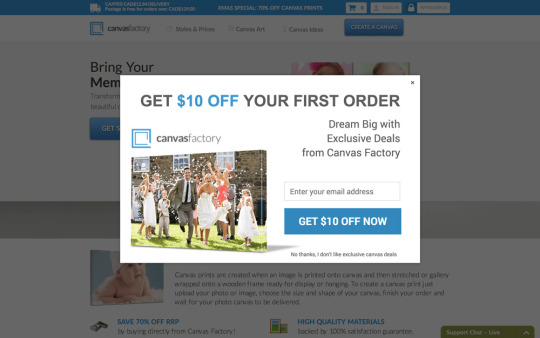
The difference came down to relevance. The offer was the same in both cases: a $10 discount on your first order for signing up for their email list. Their A/B testing confirmed the natural assumption that a discount popup will do better on a product page (where potential buyers hang out) than on a blog where visitors might just be looking for information.
Design with user experience in mind
Think of the whole visitor experience when you’re designing a popup. That’s how you achieve relevance. The best way to get them to take the journey from visitor to buyer is to consider what that path looks like for them. Then design with their perspective in mind.
If you’re promoting a product, for instance, share a discount code and get new customers to sign up with a lead gen (form) popup. If you’re having a sale, direct them to related sale items with a clickthrough popup. And if you’re sharing a piece of content, either send them to a related piece of content that nudges them closer to becoming a customer—or send them to a product that’s mentioned or is particularly relevant.
Include a strong call to action
A call to action does exactly what the name suggests: it asks readers to do something. The CTA is the focal point of a popup. It should stand out, and what it’s asking visitors to do should be obvious—even if a visitor looks it for a split second. You only get one CTA per popup; there can’t be two offers. What’s the one action you want people to take? That’s the CTA.
Be respectful
Sure, popups sometimes get a bad rap. But if you follow the above tips and avoid making the mistakes below, you can make sure yours fall on the right side of popup history.
Confirmshaming
The internet has a word for dissing people who don’t want your popup offer: confirmshaming. That’s when your opt-out option is something like, “No thanks, I like being broke and friendless,” or, “I don’t like saving money.” This snarky tactic might have been cute for the first company that used it, but now it’s so overplayed that there’s an entire Tumblr dedicated to examples of confirmshaming in action.
Besides coming off as, at best, annoying, and at worst, downright condescending, confirmshaming can completely distract from your offer.
The value of a popup is that it allows your customers to take immediate action on something that can help and benefit them. Nothing should distract from that—especially not your attitude. A visitor who’s not ready to buy today might be ready the next time they encounter your content, but not if their first encounter left them with a bad taste.
No exit option
Another issue we see too often is the popup that’s like an escape room. Clicking away from a popup should be simple and straightforward. The extra captive eyeballs you might gain by turning your ad into a click trap aren’t worth the resentment and frustration you’ll stir up. And the worst part could be that people you trap with this kind of popup strategy may have been trying to close it so they spend more time browsing your site. Talk about a self-own.
Do unto others
When in doubt, stick to the golden rule: how would you like to experience a popup, especially one you’re not interested in? Look at the nice example below. No attitude, no snottiness, just a simple “No, thank you.”

Learn from others
Marketing and advertising pros collect “swipe files” of work they like. They use these examples to learn from and as inspiration for their own work. You can do this, too. Start taking note of popups you see online and screenshot the ones that grab your attention in the right way.
When you’re designing a popup, you don’t have to reinvent the wheel. Study what works and make those elements your own by incorporating them into your design. If it catches your eye or gets you to click, the creator probably did something right. If you’re building popups in Unbounce, we have a ton of templates that allow you to plug your offer into a format that works.
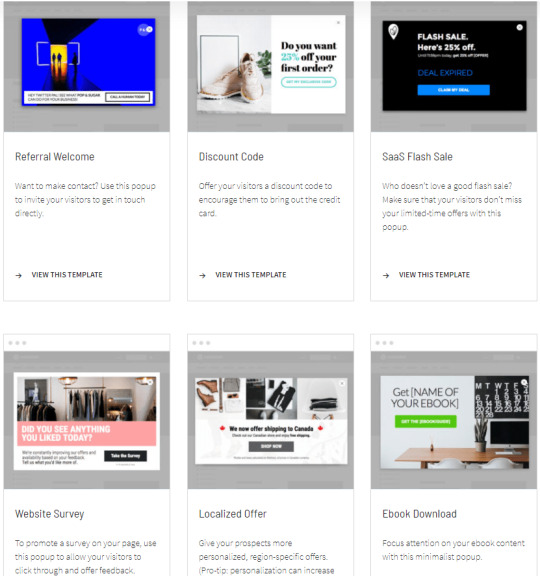
Collect data
A great thing about popups is that they can include all sorts of tracking technology that can give you insights into what’s working and what’s not—through insights like impressions, clicks, and conversion rates. Use that info to improve your offer and the design you use to present it.
That said, be deliberate when you’re testing. If you test a bunch of variables at once, you won’t know what’s working and what isn’t. Take testing one variable at a time. For example, testing the CTA and testing whether or not to have a popup triggered on exit are two different tests.
Target and Segment
Possibly the coolest thing about collecting data from your lead gen popups is that you can use it to create customer segments and Facebook “lookalike audiences” for social ad campaigns and other targeted advertising.
The popup and sticky bar builder allows you to trigger popups based on visitor behavior, like arriving at a page, exiting, or clicking a link. You can use advanced targeting features to talk to visitors based on their location or how they found your site (i.e., one popup for a visitor who followed a link in your newsletter and a different one for somebody who found you through social media).
Plus, dynamic text replacement (DTR) takes relevance to a whole other level by changing the text of your copy to match what customers are looking for based on data about their preferences.
14 Popup Design Examples to Inspire Yours
We gathered high-converting Unbounce customer popups and other examples from the world wide web to show that great popups come in all forms.
Unbounce Customer Popup Examples
National Sewing Circle

National Sewing Circle is an online platform for sewing instruction and ideas. They’re a subscription-based business that trades in information, community collaboration, and resources for avid sewers (or those who want to become one), making their popup especially clever.
With agency TN Marketing, they created an offer of a $40 sewing gift simply for signing up for their newsletter—which works as a lead nurturing strategy to eventually nudge subscribers toward signing up. Stating the dollar amount given in return for an email address makes the value crystal clear, allowing the newsletter to show the value of a full NSC membership over time. So far, this popup has converted 29% of traffic and over 70,000 visitors—and the circle continues to expand!
Regiondo

Regiondo is an activity booking software for facilitating, managing, and promoting ticket sales. Their software is robust in functionality and can be used by a range of people in a number of industries, making product information and education a key conversion driver.
This simple, no-frills popup to book a product demonstration gets visitors in the door and connected with a Regiondo team member while they may still be in the browsing or “evaluation” phase. It’s a great example of “well-designed” applying to functionality over flare—a clean, direct popup targeted to the businesses and professionals their services are for.
HiMama

HiMama is a childcare app that streamlines childcare center management, parent communication, documentation, and administrative reporting. And streamlining is exactly what their popup does, too—effectively enough to convert 40% of multiple thousands of visitors. Yowza.
Because HiMama can be used for a variety of reasons, and by people in many different roles within the childcare industry, they’ve created a self-segmenting popup that helps them best tend to visitors enquiring about the platform. Contrasting colors, benefits-focused messaging, and straightforward calls to action lead visitors to individual SaaS landing pages targeted specifically to them. Kind of like a choose-your-own-adventure that ends with everybody happy.
Sulky
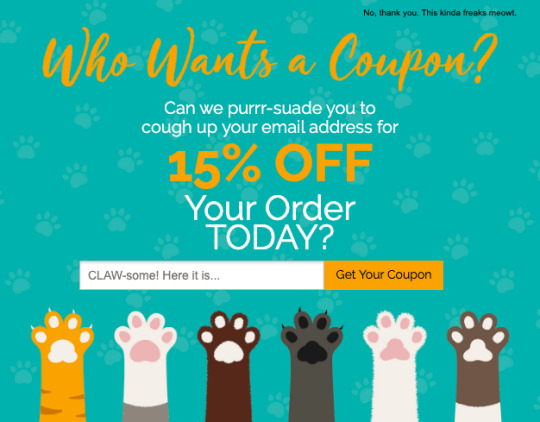
Sulky is a high-quality thread and stabilizer company that ships all over the world. They have a huge inventory of products and know that people who land on their website are there for a reason—they’ve searched for thread suppliers, clicked on an ad, or were referred—and are ready to browse, if not already primed to buy.
Placing a 15% off coupon right on their homepage is a smart way to incentivize a purchase and show appreciation to visitors before they’ve even become customers. The popup’s imagery and messaging are fun, eye-catching, and even a bit silly—in a good way! It makes for a warm, friendly invitation that’s bang-on brand and nearly impossible to refuse.
Wealthify
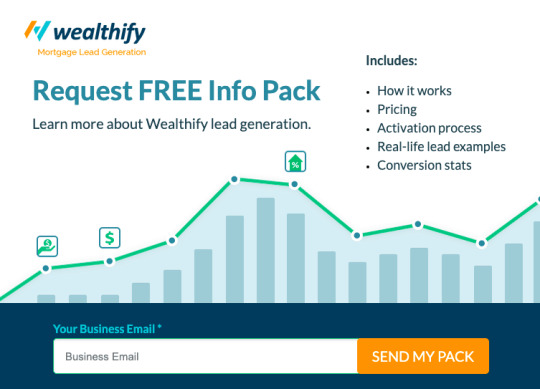
Wealthify is a lead generation service for mortgage brokers and financial planners in Australia. They turned to growth marketing agency Webbuzz to help get them more leads for potential customers. To do this, they took a softer approach that’s paid off with a steady 19% conversion rate.
“It’s been so successful that we have used the ‘info pack’ popup on other client sites,” says Ben Carew, Webbuzz’s Director of SEO Service and Analytics.
By offering an information package to learn more about Wealthify, a bulleted rundown of what’s included, and a one-field entry to sign up, they’ve made it a no-brainer trade for a visitor’s email. The clever graphics, bolded information, and clear call to action don’t hurt either!
Energy Locals
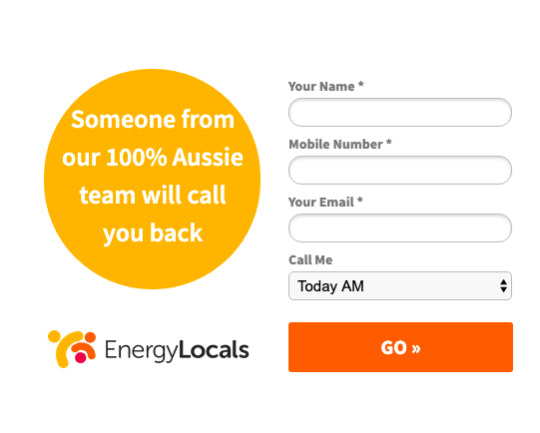
Energy Locals is an Australian energy retailer that provides clean, environmentally-friendly energy in an affordable way. Their service is location-specific and has a higher barrier to conversion than, say, buying a pair of pants, so they’ve given visitors a direct line to their 100%-local team should they have any questions or need more information.
Bright colors and minimal form fields make the popup easy to spot and easy to fill out. And the drop-down menu for when to call is a nice touch to let visitors feel in control, and know that their time is respected. At a 61% conversion rate, the proof is in the popup pudding.
Picks from Around the Web
Fun and to the point

Who doesn’t want $10? This popup cuts right to the chase and uses an upfront offer to attract customers. Meanwhile, the body copy manages to keep it light and fun. Notice that this popup appears on a product page. It’s not coming up on the blog, where a visitor might have just been browsing for an article about hoodies. Instead, it’s right on a page where a customer can take advantage of the discount and buy the hoodie.
Empathy in action

This clickthrough popup gets so much right. It focuses on the visitor’s needs and perspective and highlights a limited-time offer (with a dash of FOMO). And it gives them the chance to postpone their purchase without missing out—a win/win. Someone who’s interested but not ready to buy is going to see this and feel understood. That’s very smart.
This popup also gets points for simplicity. Remember what we said about having a single-purpose CTA? That’s what they’ve done here. They’re not asking for your email address or anything else; you just click the button to set a reminder and they’ll see you when you come back to claim that deal (at which point, they can propose a different offer, like an email signup).
“Why did you leave me?”
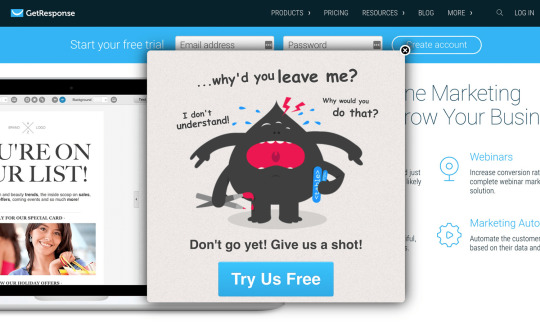
This poor lil’ creature. This one is clear, creative, and very noticeable. Even if you bounced, you probably stopped for a second to figure out who or what that little guy is.
Notice even though the CTA isn’t on top—where you might expect to see the headline—it is the largest, hardest-to-miss text. CTA buttons are great because they put your CTA and your clickthrough function in one spot. No need for clutter or complication.
Keyword: YOU
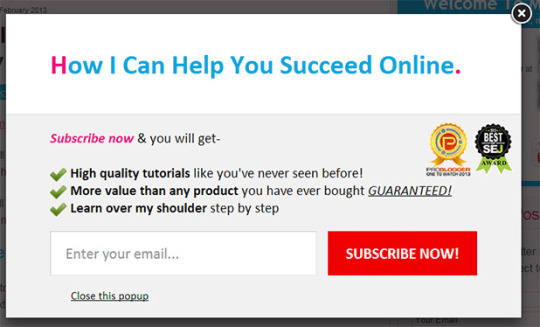
Is it mind-bendingly creative? No. But that’s okay.
This subtle, thoughtful popup does exactly what any good popup should do. It makes a clear offer that emphasizes what’s in it for you. They realize that you need a good reason to let them get in your inbox, and they’ve articulated three reasons in the body copy.
Notice how they’ve also given you two ways to leave the popup: the “X” in the top-right corner and some text at the bottom that says “close this popup.” Big points for respect and clarity.
Exclusive offers and best-kept secrets
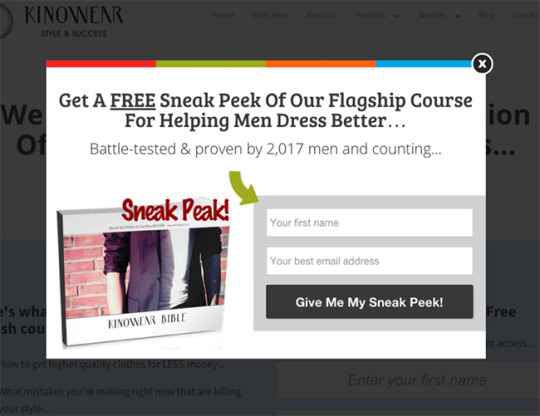
Some words never get old: New. Free. Exclusive. Let your visitors in on a secret guide or grant them membership to an exclusive club. Just be sure that what you’re offering is genuinely valuable and appealing. If you’re not careful, the secret club angle can come off like a sleazy magic trick. But done right, it’s a great way to generate curiosity.
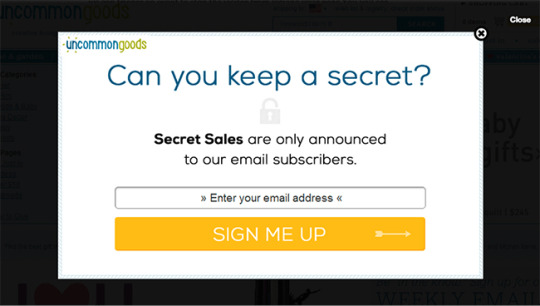
Call out objections

Sometimes it helps to address objections to your offer, especially in an exit popup. If your landing page has a high bounce rate, you may want to test popups addressing possible objections that are making them bounce. Not only will this lower your bounce rate, but it will help you better understand what customers think of your page and why they’re bouncing.
Pop “under”

Did you know a popup doesn’t need to take up the whole screen or appear right in the middle of the screen?
A simple ‘pop under’ (we call ’em sticky bars) form like this one is like a gentle reminder to join a mailing list. This example appears on a product page, but a low-key popup off to the side or down at the bottom is ideally suited for a blog because something more in-your-face might interrupt someone in the middle of a sentence.
Multiple choice

One way to be relevant is to just ask visitors what’s relevant to them. This example from a fitness site presents three choices that direct people to three tailored solutions (and organizes them into three customer segments).
The opt-in buttons are bright and attention-getting, so someone struggling with one of the three problems mentioned might see their issue before they read the question up top. This is an exit popup, so the person may be bouncing because they didn’t find content that was relevant to their specific fitness issue. This popup addresses that exact problem.
Hit the Ground Running with Popups
A well-designed popup can put your business on the fast track to more conversions, more leads, and more revenue. They’re one of the best ways to reach your customers directly and ask them to take action.
When you’re ready to include them in your marketing, try building popups in Unbounce with a free 14-day trial.
14 Inspiring Popup Design Examples to Help Grow Your Online Business published first on https://nickpontemrktg.wordpress.com/
0 notes
Text
14 Inspiring Popup Design Examples to Help Grow Your Online Business
For something that literally “pops up” in your face, the value of popups—and the variety of ways they can be used to convert more visitors—is often overlooked.
And while we’re sure the word “popup” brings some lousy user experiences to mind, don’t let a few annoying apples spoil the bunch. Popups can actually enhance your visitors’ experience and be an incredibly effective marketing tool when used in a thoughtful, targeted way. They help you highlight relevant offers, products, or sales, build email lists, and recapture your visitors’ attention before they leave the page.
With a few best practices and some steal-worthy examples, this guide is here to help you design and launch high-performing popups that convert more of your visitors into sales, leads, and customers.
Why Use Popups?
The short answer: because they work.
Popups keep people on your page, remind them of what you have to offer, and collect data to nurture leads. Think of them as your marketing sidekick with the superpower of boosting conversions.
How popups worked for these brands:
Canvas Factory used a popup to bring in $1.1 million of revenue after struggling with high traffic that didn’t convert. They used tracking integrations to fine-tune their campaign.
Entrepreneur magazine increased sales by 162% by adding a hover.
Hotjar gained 60-70 new users per month with a popup that put user experience first.
Broomberg wanted to generate more leads on a tight advertising budget. They designed a popup that increased their leads by 72%. They did this without having to spend more money on paid search advertising.
Popup Design Pro Tips
The headline is the hero
80% of people who see a piece of content will only read the headline, and a good headline can boost traffic by up to 500%.
So be sure to make the benefit of your offer clear right in the headline. This makes it easy for someone considering clicking away to know exactly what they’re turning down. Your call to action (CTA) should also be simple enough that it fits in a headline anyway.
Be clear, relevant, and concise
Like all content, you want your popups to be clear and to the point. It’s not just about the relevance of your popup to your visitors. It’s also about the relevance of your popup to the page it appears on—and the experience that you’re guiding your visitor through. Make sure it complements the content on your page instead of competing with it.
Canvas Factory found this out when they discovered a certain popup’s conversion rate on blog posts was just 0.18% compared to 11% on product pages.
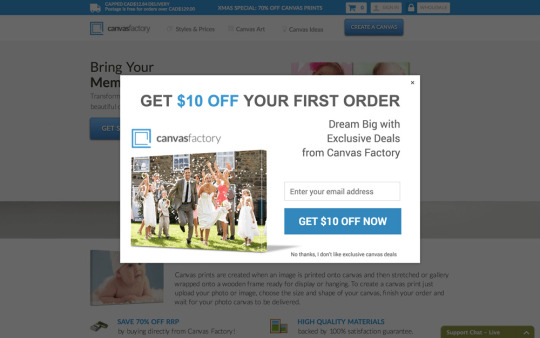
The difference came down to relevance. The offer was the same in both cases: a $10 discount on your first order for signing up for their email list. Their A/B testing confirmed the natural assumption that a discount popup will do better on a product page (where potential buyers hang out) than on a blog where visitors might just be looking for information.
Design with user experience in mind
Think of the whole visitor experience when you’re designing a popup. That’s how you achieve relevance. The best way to get them to take the journey from visitor to buyer is to consider what that path looks like for them. Then design with their perspective in mind.
If you’re promoting a product, for instance, share a discount code and get new customers to sign up with a lead gen (form) popup. If you’re having a sale, direct them to related sale items with a clickthrough popup. And if you’re sharing a piece of content, either send them to a related piece of content that nudges them closer to becoming a customer—or send them to a product that’s mentioned or is particularly relevant.
Include a strong call to action
A call to action does exactly what the name suggests: it asks readers to do something. The CTA is the focal point of a popup. It should stand out, and what it’s asking visitors to do should be obvious—even if a visitor looks it for a split second. You only get one CTA per popup; there can’t be two offers. What’s the one action you want people to take? That’s the CTA.
Be respectful
Sure, popups sometimes get a bad rap. But if you follow the above tips and avoid making the mistakes below, you can make sure yours fall on the right side of popup history.
Confirmshaming
The internet has a word for dissing people who don’t want your popup offer: confirmshaming. That’s when your opt-out option is something like, “No thanks, I like being broke and friendless,” or, “I don’t like saving money.” This snarky tactic might have been cute for the first company that used it, but now it’s so overplayed that there’s an entire Tumblr dedicated to examples of confirmshaming in action.
Besides coming off as, at best, annoying, and at worst, downright condescending, confirmshaming can completely distract from your offer.
The value of a popup is that it allows your customers to take immediate action on something that can help and benefit them. Nothing should distract from that—especially not your attitude. A visitor who’s not ready to buy today might be ready the next time they encounter your content, but not if their first encounter left them with a bad taste.
No exit option
Another issue we see too often is the popup that’s like an escape room. Clicking away from a popup should be simple and straightforward. The extra captive eyeballs you might gain by turning your ad into a click trap aren’t worth the resentment and frustration you’ll stir up. And the worst part could be that people you trap with this kind of popup strategy may have been trying to close it so they spend more time browsing your site. Talk about a self-own.
Do unto others
When in doubt, stick to the golden rule: how would you like to experience a popup, especially one you’re not interested in? Look at the nice example below. No attitude, no snottiness, just a simple “No, thank you.”

Learn from others
Marketing and advertising pros collect “swipe files” of work they like. They use these examples to learn from and as inspiration for their own work. You can do this, too. Start taking note of popups you see online and screenshot the ones that grab your attention in the right way.
When you’re designing a popup, you don’t have to reinvent the wheel. Study what works and make those elements your own by incorporating them into your design. If it catches your eye or gets you to click, the creator probably did something right. If you’re building popups in Unbounce, we have a ton of templates that allow you to plug your offer into a format that works.
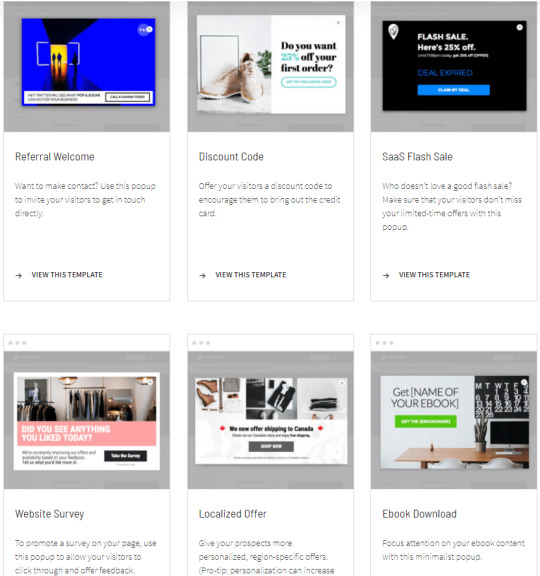
Collect data
A great thing about popups is that they can include all sorts of tracking technology that can give you insights into what’s working and what’s not—through insights like impressions, clicks, and conversion rates. Use that info to improve your offer and the design you use to present it.
That said, be deliberate when you’re testing. If you test a bunch of variables at once, you won’t know what’s working and what isn’t. Take testing one variable at a time. For example, testing the CTA and testing whether or not to have a popup triggered on exit are two different tests.
Target and Segment
Possibly the coolest thing about collecting data from your lead gen popups is that you can use it to create customer segments and Facebook “lookalike audiences” for social ad campaigns and other targeted advertising.
The popup and sticky bar builder allows you to trigger popups based on visitor behavior, like arriving at a page, exiting, or clicking a link. You can use advanced targeting features to talk to visitors based on their location or how they found your site (i.e., one popup for a visitor who followed a link in your newsletter and a different one for somebody who found you through social media).
Plus, dynamic text replacement (DTR) takes relevance to a whole other level by changing the text of your copy to match what customers are looking for based on data about their preferences.
14 Popup Design Examples to Inspire Yours
We gathered high-converting Unbounce customer popups and other examples from the world wide web to show that great popups come in all forms.
Unbounce Customer Popup Examples
National Sewing Circle

National Sewing Circle is an online platform for sewing instruction and ideas. They’re a subscription-based business that trades in information, community collaboration, and resources for avid sewers (or those who want to become one), making their popup especially clever.
With agency TN Marketing, they created an offer of a $40 sewing gift simply for signing up for their newsletter—which works as a lead nurturing strategy to eventually nudge subscribers toward signing up. Stating the dollar amount given in return for an email address makes the value crystal clear, allowing the newsletter to show the value of a full NSC membership over time. So far, this popup has converted 29% of traffic and over 70,000 visitors—and the circle continues to expand!
Regiondo

Regiondo is an activity booking software for facilitating, managing, and promoting ticket sales. Their software is robust in functionality and can be used by a range of people in a number of industries, making product information and education a key conversion driver.
This simple, no-frills popup to book a product demonstration gets visitors in the door and connected with a Regiondo team member while they may still be in the browsing or “evaluation” phase. It’s a great example of “well-designed” applying to functionality over flare—a clean, direct popup targeted to the businesses and professionals their services are for.
HiMama
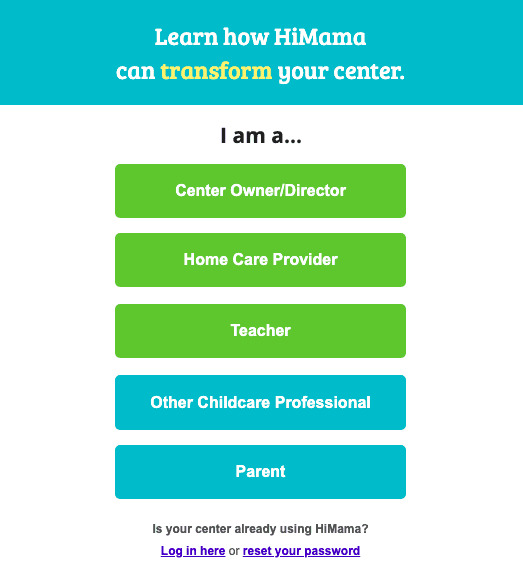
HiMama is a childcare app that streamlines childcare center management, parent communication, documentation, and administrative reporting. And streamlining is exactly what their popup does, too—effectively enough to convert 40% of multiple thousands of visitors. Yowza.
Because HiMama can be used for a variety of reasons, and by people in many different roles within the childcare industry, they’ve created a self-segmenting popup that helps them best tend to visitors enquiring about the platform. Contrasting colors, benefits-focused messaging, and straightforward calls to action lead visitors to individual SaaS landing pages targeted specifically to them. Kind of like a choose-your-own-adventure that ends with everybody happy.
Sulky

Sulky is a high-quality thread and stabilizer company that ships all over the world. They have a huge inventory of products and know that people who land on their website are there for a reason—they’ve searched for thread suppliers, clicked on an ad, or were referred—and are ready to browse, if not already primed to buy.
Placing a 15% off coupon right on their homepage is a smart way to incentivize a purchase and show appreciation to visitors before they’ve even become customers. The popup’s imagery and messaging are fun, eye-catching, and even a bit silly—in a good way! It makes for a warm, friendly invitation that’s bang-on brand and nearly impossible to refuse.
Wealthify
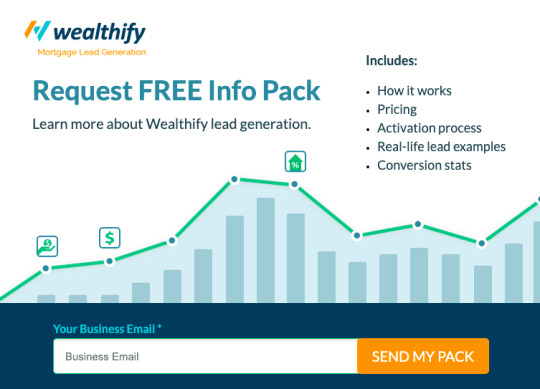
Wealthify is a lead generation service for mortgage brokers and financial planners in Australia. They turned to growth marketing agency Webbuzz to help get them more leads for potential customers. To do this, they took a softer approach that’s paid off with a steady 19% conversion rate.
“It’s been so successful that we have used the ‘info pack’ popup on other client sites,” says Ben Carew, Webbuzz’s Director of SEO Service and Analytics.
By offering an information package to learn more about Wealthify, a bulleted rundown of what’s included, and a one-field entry to sign up, they’ve made it a no-brainer trade for a visitor’s email. The clever graphics, bolded information, and clear call to action don’t hurt either!
Energy Locals

Energy Locals is an Australian energy retailer that provides clean, environmentally-friendly energy in an affordable way. Their service is location-specific and has a higher barrier to conversion than, say, buying a pair of pants, so they’ve given visitors a direct line to their 100%-local team should they have any questions or need more information.
Bright colors and minimal form fields make the popup easy to spot and easy to fill out. And the drop-down menu for when to call is a nice touch to let visitors feel in control, and know that their time is respected. At a 61% conversion rate, the proof is in the popup pudding.
Picks from Around the Web
Fun and to the point
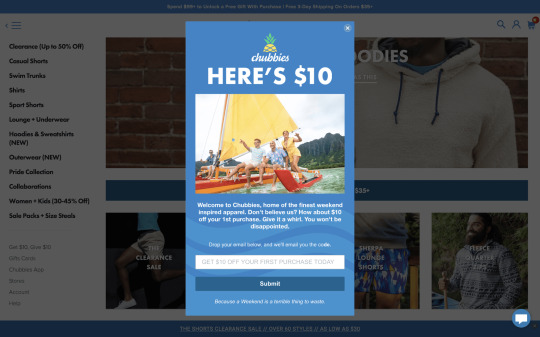
Who doesn’t want $10? This popup cuts right to the chase and uses an upfront offer to attract customers. Meanwhile, the body copy manages to keep it light and fun. Notice that this popup appears on a product page. It’s not coming up on the blog, where a visitor might have just been browsing for an article about hoodies. Instead, it’s right on a page where a customer can take advantage of the discount and buy the hoodie.
Empathy in action

This clickthrough popup gets so much right. It focuses on the visitor’s needs and perspective and highlights a limited-time offer (with a dash of FOMO). And it gives them the chance to postpone their purchase without missing out—a win/win. Someone who’s interested but not ready to buy is going to see this and feel understood. That’s very smart.
This popup also gets points for simplicity. Remember what we said about having a single-purpose CTA? That’s what they’ve done here. They’re not asking for your email address or anything else; you just click the button to set a reminder and they’ll see you when you come back to claim that deal (at which point, they can propose a different offer, like an email signup).
“Why did you leave me?”
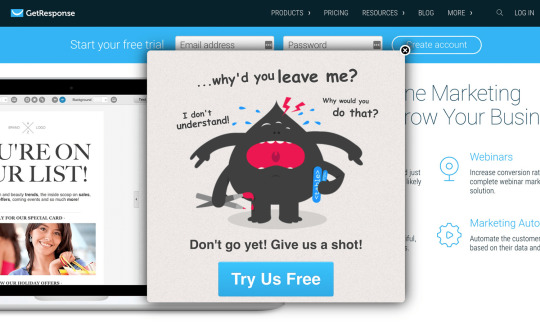
This poor lil’ creature. This one is clear, creative, and very noticeable. Even if you bounced, you probably stopped for a second to figure out who or what that little guy is.
Notice even though the CTA isn’t on top—where you might expect to see the headline—it is the largest, hardest-to-miss text. CTA buttons are great because they put your CTA and your clickthrough function in one spot. No need for clutter or complication.
Keyword: YOU
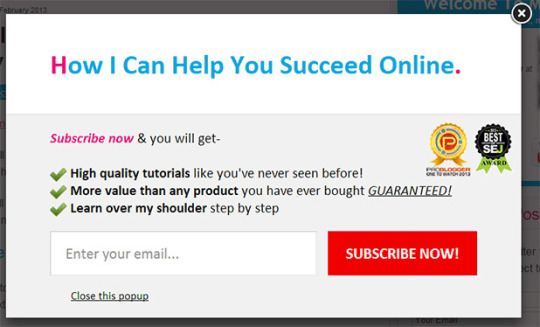
Is it mind-bendingly creative? No. But that’s okay.
This subtle, thoughtful popup does exactly what any good popup should do. It makes a clear offer that emphasizes what’s in it for you. They realize that you need a good reason to let them get in your inbox, and they’ve articulated three reasons in the body copy.
Notice how they’ve also given you two ways to leave the popup: the “X” in the top-right corner and some text at the bottom that says “close this popup.” Big points for respect and clarity.
Exclusive offers and best-kept secrets
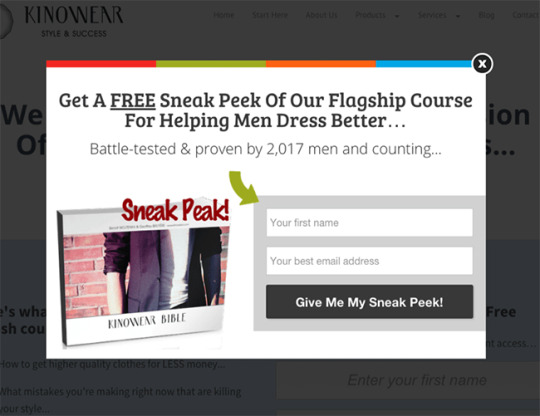
Some words never get old: New. Free. Exclusive. Let your visitors in on a secret guide or grant them membership to an exclusive club. Just be sure that what you’re offering is genuinely valuable and appealing. If you’re not careful, the secret club angle can come off like a sleazy magic trick. But done right, it’s a great way to generate curiosity.
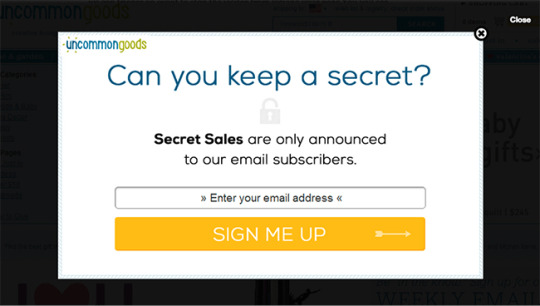
Call out objections

Sometimes it helps to address objections to your offer, especially in an exit popup. If your landing page has a high bounce rate, you may want to test popups addressing possible objections that are making them bounce. Not only will this lower your bounce rate, but it will help you better understand what customers think of your page and why they’re bouncing.
Pop “under”

Did you know a popup doesn’t need to take up the whole screen or appear right in the middle of the screen?
A simple ‘pop under’ (we call ’em sticky bars) form like this one is like a gentle reminder to join a mailing list. This example appears on a product page, but a low-key popup off to the side or down at the bottom is ideally suited for a blog because something more in-your-face might interrupt someone in the middle of a sentence.
Multiple choice
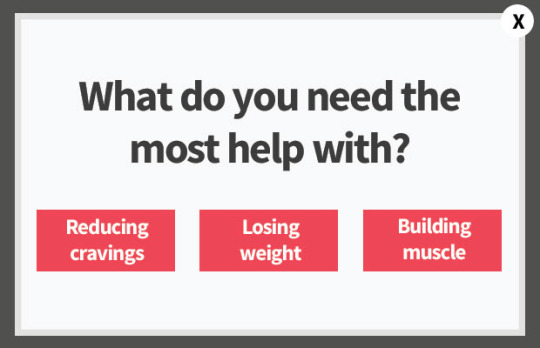
One way to be relevant is to just ask visitors what’s relevant to them. This example from a fitness site presents three choices that direct people to three tailored solutions (and organizes them into three customer segments).
The opt-in buttons are bright and attention-getting, so someone struggling with one of the three problems mentioned might see their issue before they read the question up top. This is an exit popup, so the person may be bouncing because they didn’t find content that was relevant to their specific fitness issue. This popup addresses that exact problem.
Hit the Ground Running with Popups
A well-designed popup can put your business on the fast track to more conversions, more leads, and more revenue. They’re one of the best ways to reach your customers directly and ask them to take action.
When you’re ready to include them in your marketing, try building popups in Unbounce with a free 14-day trial.
from Marketing https://unbounce.com/conversion-rate-optimization/14-inspiring-popup-design-examples-to-help-grow-your-online-business/ via http://www.rssmix.com/
0 notes
Text
Family Day Care Chatswood
Educators provide education and care for young children. These centers offer a variety of programs, including Spanish lessons, arts and crafts, music lessons, and dance classes. Parents are able to choose from a variety of affordable fees. A family day care Chatswood is a great way to ensure that your child's future is bright.
A Bright Beginning Early Learning Centre
• Our Early Childhood and Primary School Teachers hold 4-year trained university degrees & other educators hold either a Diploma of Childcare or a Certificate III.
• We provide morning tea, hot lunch, afternoon tea and a late snack.
• We engage children with various specialist incursion events.
• We have different events & celebrations throughout the year, listed on our events calendar. Eg: various multicultural Celebrations, dance performances, egg hatching, Healthy Harold, Earth day to name a few, Graduation for the 4-5’s and an end of year celebration for each classroom.
• We upload significant moments of your child’s day on Storypark so that you can keep connected to their learning, and have something to chat about on the way home.
• We document your child’s learning through photos, writing, film and art port-folios to capture the essence of their learning. Through Storypark you can access all information from your child’s portfolio to special events and a yearly calendar.
• We provide wipes, water, a full brimmed sun hat, sun-cream and all educational and art supplies for your child.
• All our Staff are trained in Munch & Moves/which is a eat well & get active program that is integrated into our daily program.
Moovit helps you find the best way to get to Family Day Care
If you need to find the best way to get to Family Day care Chatswood, Moovit is a fantastic app to help you do just that. It is an all-in-one transit app that can be downloaded for free on your mobile phone or tablet. It shows you the quickest route and can even warn you about overcrowded transit. This app can save you time and money while you're traveling by making your commute easier.
Educators provide education and care for young children
The educators at Family Day Care Chatswood provide education and care for young children in a home-like setting. In addition, the educators also work with the local coordination unit for regular visits and support. The child care service is open from 7am to 6pm, Monday to Friday.
Programs are available in Chatswood
There are many great programs available for your little one to attend. The KU Chatswood Community Preschool offers programs such as Spanish, dance, arts and crafts, and music lessons. In addition to being an excellent early childhood education center, these programs also provide a fun and social environment for your child to explore.
Fees are reasonable
Family day care in Chatswood costs around $155 per day on average. Fees vary based on the number of hours a child needs care and the type of center they attend. Fees can be reduced by choosing a family daycare provider or choosing a centre with a lower tuition rate. The age of the child is also a factor in determining the cost of daycare.
Abbaroseville have been in the business of children for over 48 years. Family operated & owned and first established at our Crows Nest Centre in 1972 we have had the pleasure of teaching & educating children throughout their many milestones and have loved every moment of it, we really would not have it any-other way.
#family day care chatswood#preschool chatswood nsw#childcare roseville#roseville kindergarten#daycare in roseville#daycare roseville#roseville preschool kindergarten#kindergarten chatswood
0 notes
Text
65 Free Tools to Help You Through the Coronavirus Pandemic

Opinions expressed by Entrepreneur contributors are their own.
There are more than 10,000 coronavirus cases and more than 150 deaths in the U.S., according to the CDC. The stock market has taken a hit. Businesses are losing customers, and workers are losing jobs. It has become frightening, frustrating and even maddening.
In response to the pandemic, Zoom CEO Eric Yuan recently reminded us that we can all help each other in our own ways. He has provided K-12 educators with free access to the videoconferencing platform so students can continue learning.
Inspired, I shared an idea with Jason Feifer, editor in chief at Entrepreneur: a simple, organized list of free product and service offerings from all types of companies. Access to these powerful tools can help organizations, teams and families.
He responded quickly. “I like that. Maybe it starts as a post on Entrepreneur.com?”
Boom. Here we go:
Zoom: Free videoconferencing tools for K-through-12 schools.
Slack: Free upgrades to paid plans for teams working on coronavirus pandemic research, response or mitigation. Interested teams can email a special address to get this set up, and a consultation on how best to get started with remote collaboration.
Humu: Free nudges to anyone who wants science-backed advice for how to best work remotely, partner with colleagues who are all over the place, show appreciation for those who don’t have the flexibility to work remotely (e.g. cashiers, medical personnel).
Atlassian: Free access to Cloud products for issue-tracking and project-tracking software including Jira and Confluence. Also, free access to Trello Business Class for organizing plans is offered for one year to educators at K through 12 and higher education.
Airtable: Free use of Airtable Pro plan as a modern database for any non-political, humanitarian effort tackling COVID relief. There is no time limit. It is also planning to make the service free for students too.
PandaDoc: Free e-sign plan gives companies unlimited users, unlimited document uploads, unlimited eSignatures, and payment processing.
Wrike: Free licenses of the versatile collaborative work management platform (Professional edition) to new customers for 6 months. Current customers are able to add unlimited collaborators. Webinars and advice on remote work are both on the website.
Calendly: Free Zoom and GoToMeeting integrations for their online appointment scheduling software to help remote workers stay connected. These were previously Premium tier features and will be available through June 30. Also Free premium plan access to teams working directly on COVID-19.
Smartsheet: Free templates that can be used by other organizations to build their own coronavirus preparedness dashboard, rich with CDC documentation and other resources, and related sheets and forms.
Support.com: Free tech support to anyone working or studying remotely right now.
Bill.com: Free 90-day subscription for new customers impacted by COVID-19. The cloud-based service helps small and mid-sized businesses to automate the processing of bills, generate invoices, send/receive payments and manage their cash flows.
Workable: Free use of the new video interviewing software for all customers, and access to a library of COVID-19 response content for use by HR professionals and business leaders.
Zoho: Free suite of Remotely apps until July 1. There are 11 apps in all, including ones for online meetings, training sessions, storage, project management and everyday work (in the form of word processing, spreadsheets and presentations).
Google: Free, premium version of its workplace video chat tool until July, to help businesses and schools working remotely due to coronavirus. Those features include having up to 250 participants per call, live streaming for up to 100,000 viewers within a domain, and the ability to record meetings and save them to Google Drive.
Cisco: Free license for new customers of Duo Security’s two-factor authentication tool, and current customers can go above their user limit as their employees increasingly work from home. Same deal for its web security tool Umbrella and its VPN product AnyConnect, which is available until July 1. Cisco is extending services for existing customers of Webex, its video conference platform. The offer includes unlimited usage without time restriction, support for fewer than 100 participants, and toll-free dial-in.
Comcast: Free Xfinity WiFi for everyone, with hotspots available to all, including non-Xfinity subscribers. To access the service, look for the “xfinitywifi” network name in a list of hotspots.
LogMeIn: Free site-wide licensing for 3 months of its videoconferencing solution, GoToMeeting, for eligible organizations (health care providers, educational institutions, municipalities and non-profits).
Loom: Free video recording and sharing service for teachers and students at K-through-12 schools, universities and educational institutions. They have also removed the recording limit on free plans and have cut the price for Loom Pro in half.
Microsoft: Free six-month Office 365 E1 Trial, including Microsoft Teams.
Slashtop: Free 60-day licenses to its Business Access remote access software.
Discord: Free, enhanced Go Live streaming service so that it can now support 50 simultaneous users rather than 10.
EZTexting: Free emergency text alert services to schools. Receive 100,000 free outgoing text messages for six months, access to a set of coronavirus message templates, and one-on-one consulting.
Yext: Free, new site search product, Yext Answers, for a 90-day period. Eligible businesses will be able to transform their website into a search engine capable of answering consumers’ COVID-19 specific queries in real time.
Linkedin: Free 16 learning courses that provide tips on how to stay productive, build relationships when you’re not face-to-face, use virtual meeting tools and balance family and work dynamics in a healthy way.
Hootsuite: Free access for Hootsuite Professional to small businesses and nonprofits until July 1. Helping to manage social media, and stay connected with your customers and communities.
Amazon: Free online access to sponsored computer science courses in the United States. That’s intended for learners in grades 6 through 12, and teachers who are remotely teaching this age group. Parents can also access this curriculum.
Brit.co: Free DIY classes for the next one to two weeks. Use discount code “selfcare” at checkout.
Zencastr: Free Hobbyist plans will have no recording time limits or limits on the number of people in your recording. Effective through July 1.
Threads: Free access to their collaboration tools and Pro/Team plans for all users through July 1.
Expensify: Reimbursement of up to $50 for essential goods and groceries purchased on your SNAP card.
Wave: Free financial software solutions (accounting, bookkeeping, invoicing) for small businesses to help with cash flow — which becomes increasingly important during economic turmoil. In response to COVID-19, Wave has reduced paid services where possible to active customers, in an effort to provide financial relief during a time of need.
Jamm: Free audio-visual communication tool used by remote and distributed teams. You can quickly record videos or do a live call with your team. Available for 3 months.
Carto: Free visualization software for organizations fighting COVID-19.
Crowdmark: Free access to its online grading and analytics platform until May 31.
Epic: Free remote access of its reading platform to elementary educators and librarians until June 30, with no credit card required. Students may access the company’s digital library, which has 35,000-plus books, read-to-me and audiobooks, videos and quizzes. Teachers and librarians can stay connected to their students by assigning books or collections and monitoring their progress.
ClassTag: Free communication platform available to help districts and schools communicate with their families. The software sends messages through SMS, email, apps and the web and automatically translates them into one of 55 languages. The platform can also be used to post videos, assignments and other resources for students to access at home and allow users to run virtual lessons with a videoconferencing tool.
McGraw-Hill: Free resources for out-of-school learning to help K-12 teachers make the transition to remote instruction.
Scholastic: Free 5 days’ worth of content and 15 additional days is on the way.
Age of Learning: Free at-home access for families at affected schools to ABCmouse, a learning resource for ages 2 to 8.
Listenwise: Free access to the Listenwise platform that supports distance learning by allowing you to roster your students, make online customized written assignments, and assign multiple-choice autos-cored listening quizzes. This will give you and your students the ability to learn through May 31, or until your school reopens.
Peloton: Free 90-day trial of its subscription workout app as more gyms shut down in response to the coronavirus pandemic. The fitness freebie doesn’t require a Peloton-branded bike or treadmill. Users can choose from classes such as yoga, meditation, strength training and more.
U-Haul: Free self-storage for 30 days to all college students who have been impacted by schedule changes at their universities.
TripIt: Free 6-month licenses to their Tripit Pro flight tracking service.
UrbanSitter: Free parent subscription for two months during the COVID-19 outbreak. Parents can find trusted childcare help to support them as they work from home during this period. Every sitter is background checked and UrbanSitter provides parents with as much information as possible to make informed decisions.
Dialpad: Free two months of its cloud-based phone system, Dialpad Talk Pro. This also includes videoconferences and UberConference Business.
1Password: Free business accounts for the first 6 months. Manage your workforce from anywhere, and safely share logins and other important resources with remote workers.
Vidyard: Free secure video messaging to enhance internal communications for all businesses.
Cloudfare: Free Teams products to small businesses and remote workers to operate securely and easily. This policy will continue for at least the next 6 months.
Panopto: Free three-month access to capture and distribute video content for businesses, universities, colleges and schools will enable employees and students to continue learning and working remotely.
OneLogin: Free access to the Trusted Experience Platform

for educators who are moving to a virtual learning environment in light of health concerns. The free platform, consisting of single sign-on (SSO), multi-factor authentication (MFA) and certificate-based authentication, will deliver secure virtual experiences for all educators K through 12, colleges and universities.
SentinelLabs: Free cybersecurity platform SentinelOne Core between Monday, March 16 through Friday, May 16. SentinelOne’s cloud-based platform seamlessly scales, making it well suited to protect both businesses and employees rapidly transitioning to a work-from-home environment.
Waterfall Security: Free Remote Screen View product licenses available to customers whose vendor personnel or key employees are no longer able to travel to industrial and critical infrastructure sites. Remote Screen View sends real-time images of industrial workstations to a web server that remote vendors can access.
OneClick: Free remote access Basic Starter Package for the next three months to assist those working remotely.
8×8: Free video meetings to all users. Offers 80+ local dial-in numbers (11 toll-free) from 55+ countries and meetings of up to 50 participants without any time restrictions.
Bloomz: Free premium version of its communication service to all schools through June 30. The software allows users to communicate updates in real-time to parents and students; and share lessons, student work and feedback.
HR Acuity: Free version of its SaaS solution to help businesses manage employee issues related to the coronavirus (COVID-19) outbreak. The limited edition provides employee documentation and tracking functionality that will equip businesses to monitor the people impact of the crisis. The limited edition will be available through at least July 1 to businesses with more than 100 employees.
Avid: Free, temporary licenses of creative tools to qualified media enterprise and educational customers. Starting March 16 through April 17, users who must work remotely because their facility has been closed may obtain 90-day licenses free of charge for Media Composer | Ultimate, Pro Tools, Pro Tools | Ultimate and Sibelius | Ultimate. In addition, any student of an institution who uses our products and can no longer attend school and/or access school facilities can receive a 90-day license of the same products.
TechSmith: Free licenses to TechSmith Snagit screen capture software and the TechSmith Video Review software through June 30.
BlueJeans: Free access to videoconference service to first responders and NGOs for 90-days.
Adobe: Free home access to Creative Cloud apps is available by request of students and educators until May 31. Adobe also offers free 90-day access to Adobe Connect for web conferencing until July 1.
DropBox: Free DropBox Business and HelloSign Enterprise subscriptions for a three-month period to nonprofits and NGOs that are focused on fighting COVID-19. Organizations working to stop the virus or providing relief to those impacted are encouraged to apply.
Box: Free secure file sharing and collaboration platform for 3 months. The offer is for the Business plan and includes unlimited storage, mobile access, and advanced user and security reporting.
Mailchimp: Free Standard accounts to eligible groups sending critical public health information about COVID-19 through June 30.
SurveyMonkey: Free questionnaire templates written by survey research experts to gather data/feedback from employees, customers and broader groups impacted by the coronavirus.
Salesforce: Free access to technology for emergency response teams, call centers, and care management teams for health systems affected by coronavirus.
Check back soon because we’ll keep this list updated. You can also see all links and submit new free offers here.

Website Design & SEO Delray Beach by DBL07.co
Delray Beach SEO
source http://www.scpie.org/65-free-tools-to-help-you-through-the-coronavirus-pandemic/ source https://scpie.tumblr.com/post/613221212725837824
0 notes
Text
65 Free Tools to Help You Through the Coronavirus Pandemic

Opinions expressed by Entrepreneur contributors are their own.
There are more than 10,000 coronavirus cases and more than 150 deaths in the U.S., according to the CDC. The stock market has taken a hit. Businesses are losing customers, and workers are losing jobs. It has become frightening, frustrating and even maddening.
In response to the pandemic, Zoom CEO Eric Yuan recently reminded us that we can all help each other in our own ways. He has provided K-12 educators with free access to the videoconferencing platform so students can continue learning.
Inspired, I shared an idea with Jason Feifer, editor in chief at Entrepreneur: a simple, organized list of free product and service offerings from all types of companies. Access to these powerful tools can help organizations, teams and families.
He responded quickly. “I like that. Maybe it starts as a post on Entrepreneur.com?”
Boom. Here we go:
Zoom: Free videoconferencing tools for K-through-12 schools.
Slack: Free upgrades to paid plans for teams working on coronavirus pandemic research, response or mitigation. Interested teams can email a special address to get this set up, and a consultation on how best to get started with remote collaboration.
Humu: Free nudges to anyone who wants science-backed advice for how to best work remotely, partner with colleagues who are all over the place, show appreciation for those who don’t have the flexibility to work remotely (e.g. cashiers, medical personnel).
Atlassian: Free access to Cloud products for issue-tracking and project-tracking software including Jira and Confluence. Also, free access to Trello Business Class for organizing plans is offered for one year to educators at K through 12 and higher education.
Airtable: Free use of Airtable Pro plan as a modern database for any non-political, humanitarian effort tackling COVID relief. There is no time limit. It is also planning to make the service free for students too.
PandaDoc: Free e-sign plan gives companies unlimited users, unlimited document uploads, unlimited eSignatures, and payment processing.
Wrike: Free licenses of the versatile collaborative work management platform (Professional edition) to new customers for 6 months. Current customers are able to add unlimited collaborators. Webinars and advice on remote work are both on the website.
Calendly: Free Zoom and GoToMeeting integrations for their online appointment scheduling software to help remote workers stay connected. These were previously Premium tier features and will be available through June 30. Also Free premium plan access to teams working directly on COVID-19.
Smartsheet: Free templates that can be used by other organizations to build their own coronavirus preparedness dashboard, rich with CDC documentation and other resources, and related sheets and forms.
Support.com: Free tech support to anyone working or studying remotely right now.
Bill.com: Free 90-day subscription for new customers impacted by COVID-19. The cloud-based service helps small and mid-sized businesses to automate the processing of bills, generate invoices, send/receive payments and manage their cash flows.
Workable: Free use of the new video interviewing software for all customers, and access to a library of COVID-19 response content for use by HR professionals and business leaders.
Zoho: Free suite of Remotely apps until July 1. There are 11 apps in all, including ones for online meetings, training sessions, storage, project management and everyday work (in the form of word processing, spreadsheets and presentations).
Google: Free, premium version of its workplace video chat tool until July, to help businesses and schools working remotely due to coronavirus. Those features include having up to 250 participants per call, live streaming for up to 100,000 viewers within a domain, and the ability to record meetings and save them to Google Drive.
Cisco: Free license for new customers of Duo Security’s two-factor authentication tool, and current customers can go above their user limit as their employees increasingly work from home. Same deal for its web security tool Umbrella and its VPN product AnyConnect, which is available until July 1. Cisco is extending services for existing customers of Webex, its video conference platform. The offer includes unlimited usage without time restriction, support for fewer than 100 participants, and toll-free dial-in.
Comcast: Free Xfinity WiFi for everyone, with hotspots available to all, including non-Xfinity subscribers. To access the service, look for the “xfinitywifi” network name in a list of hotspots.
LogMeIn: Free site-wide licensing for 3 months of its videoconferencing solution, GoToMeeting, for eligible organizations (health care providers, educational institutions, municipalities and non-profits).
Loom: Free video recording and sharing service for teachers and students at K-through-12 schools, universities and educational institutions. They have also removed the recording limit on free plans and have cut the price for Loom Pro in half.
Microsoft: Free six-month Office 365 E1 Trial, including Microsoft Teams.
Slashtop: Free 60-day licenses to its Business Access remote access software.
Discord: Free, enhanced Go Live streaming service so that it can now support 50 simultaneous users rather than 10.
EZTexting: Free emergency text alert services to schools. Receive 100,000 free outgoing text messages for six months, access to a set of coronavirus message templates, and one-on-one consulting.
Yext: Free, new site search product, Yext Answers, for a 90-day period. Eligible businesses will be able to transform their website into a search engine capable of answering consumers’ COVID-19 specific queries in real time.
Linkedin: Free 16 learning courses that provide tips on how to stay productive, build relationships when you’re not face-to-face, use virtual meeting tools and balance family and work dynamics in a healthy way.
Hootsuite: Free access for Hootsuite Professional to small businesses and nonprofits until July 1. Helping to manage social media, and stay connected with your customers and communities.
Amazon: Free online access to sponsored computer science courses in the United States. That’s intended for learners in grades 6 through 12, and teachers who are remotely teaching this age group. Parents can also access this curriculum.
Brit.co: Free DIY classes for the next one to two weeks. Use discount code “selfcare” at checkout.
Zencastr: Free Hobbyist plans will have no recording time limits or limits on the number of people in your recording. Effective through July 1.
Threads: Free access to their collaboration tools and Pro/Team plans for all users through July 1.
Expensify: Reimbursement of up to $50 for essential goods and groceries purchased on your SNAP card.
Wave: Free financial software solutions (accounting, bookkeeping, invoicing) for small businesses to help with cash flow — which becomes increasingly important during economic turmoil. In response to COVID-19, Wave has reduced paid services where possible to active customers, in an effort to provide financial relief during a time of need.
Jamm: Free audio-visual communication tool used by remote and distributed teams. You can quickly record videos or do a live call with your team. Available for 3 months.
Carto: Free visualization software for organizations fighting COVID-19.
Crowdmark: Free access to its online grading and analytics platform until May 31.
Epic: Free remote access of its reading platform to elementary educators and librarians until June 30, with no credit card required. Students may access the company’s digital library, which has 35,000-plus books, read-to-me and audiobooks, videos and quizzes. Teachers and librarians can stay connected to their students by assigning books or collections and monitoring their progress.
ClassTag: Free communication platform available to help districts and schools communicate with their families. The software sends messages through SMS, email, apps and the web and automatically translates them into one of 55 languages. The platform can also be used to post videos, assignments and other resources for students to access at home and allow users to run virtual lessons with a videoconferencing tool.
McGraw-Hill: Free resources for out-of-school learning to help K-12 teachers make the transition to remote instruction.
Scholastic: Free 5 days’ worth of content and 15 additional days is on the way.
Age of Learning: Free at-home access for families at affected schools to ABCmouse, a learning resource for ages 2 to 8.
Listenwise: Free access to the Listenwise platform that supports distance learning by allowing you to roster your students, make online customized written assignments, and assign multiple-choice autos-cored listening quizzes. This will give you and your students the ability to learn through May 31, or until your school reopens.
Peloton: Free 90-day trial of its subscription workout app as more gyms shut down in response to the coronavirus pandemic. The fitness freebie doesn’t require a Peloton-branded bike or treadmill. Users can choose from classes such as yoga, meditation, strength training and more.
U-Haul: Free self-storage for 30 days to all college students who have been impacted by schedule changes at their universities.
TripIt: Free 6-month licenses to their Tripit Pro flight tracking service.
UrbanSitter: Free parent subscription for two months during the COVID-19 outbreak. Parents can find trusted childcare help to support them as they work from home during this period. Every sitter is background checked and UrbanSitter provides parents with as much information as possible to make informed decisions.
Dialpad: Free two months of its cloud-based phone system, Dialpad Talk Pro. This also includes videoconferences and UberConference Business.
1Password: Free business accounts for the first 6 months. Manage your workforce from anywhere, and safely share logins and other important resources with remote workers.
Vidyard: Free secure video messaging to enhance internal communications for all businesses.
Cloudfare: Free Teams products to small businesses and remote workers to operate securely and easily. This policy will continue for at least the next 6 months.
Panopto: Free three-month access to capture and distribute video content for businesses, universities, colleges and schools will enable employees and students to continue learning and working remotely.
OneLogin: Free access to the Trusted Experience Platform

for educators who are moving to a virtual learning environment in light of health concerns. The free platform, consisting of single sign-on (SSO), multi-factor authentication (MFA) and certificate-based authentication, will deliver secure virtual experiences for all educators K through 12, colleges and universities.
SentinelLabs: Free cybersecurity platform SentinelOne Core between Monday, March 16 through Friday, May 16. SentinelOne’s cloud-based platform seamlessly scales, making it well suited to protect both businesses and employees rapidly transitioning to a work-from-home environment.
Waterfall Security: Free Remote Screen View product licenses available to customers whose vendor personnel or key employees are no longer able to travel to industrial and critical infrastructure sites. Remote Screen View sends real-time images of industrial workstations to a web server that remote vendors can access.
OneClick: Free remote access Basic Starter Package for the next three months to assist those working remotely.
8×8: Free video meetings to all users. Offers 80+ local dial-in numbers (11 toll-free) from 55+ countries and meetings of up to 50 participants without any time restrictions.
Bloomz: Free premium version of its communication service to all schools through June 30. The software allows users to communicate updates in real-time to parents and students; and share lessons, student work and feedback.
HR Acuity: Free version of its SaaS solution to help businesses manage employee issues related to the coronavirus (COVID-19) outbreak. The limited edition provides employee documentation and tracking functionality that will equip businesses to monitor the people impact of the crisis. The limited edition will be available through at least July 1 to businesses with more than 100 employees.
Avid: Free, temporary licenses of creative tools to qualified media enterprise and educational customers. Starting March 16 through April 17, users who must work remotely because their facility has been closed may obtain 90-day licenses free of charge for Media Composer | Ultimate, Pro Tools, Pro Tools | Ultimate and Sibelius | Ultimate. In addition, any student of an institution who uses our products and can no longer attend school and/or access school facilities can receive a 90-day license of the same products.
TechSmith: Free licenses to TechSmith Snagit screen capture software and the TechSmith Video Review software through June 30.
BlueJeans: Free access to videoconference service to first responders and NGOs for 90-days.
Adobe: Free home access to Creative Cloud apps is available by request of students and educators until May 31. Adobe also offers free 90-day access to Adobe Connect for web conferencing until July 1.
DropBox: Free DropBox Business and HelloSign Enterprise subscriptions for a three-month period to nonprofits and NGOs that are focused on fighting COVID-19. Organizations working to stop the virus or providing relief to those impacted are encouraged to apply.
Box: Free secure file sharing and collaboration platform for 3 months. The offer is for the Business plan and includes unlimited storage, mobile access, and advanced user and security reporting.
Mailchimp: Free Standard accounts to eligible groups sending critical public health information about COVID-19 through June 30.
SurveyMonkey: Free questionnaire templates written by survey research experts to gather data/feedback from employees, customers and broader groups impacted by the coronavirus.
Salesforce: Free access to technology for emergency response teams, call centers, and care management teams for health systems affected by coronavirus.
Check back soon because we’ll keep this list updated. You can also see all links and submit new free offers here.

Website Design & SEO Delray Beach by DBL07.co
Delray Beach SEO
source http://www.scpie.org/65-free-tools-to-help-you-through-the-coronavirus-pandemic/
0 notes
Text
Tips for Making Lasting Changes in the New Year

Finally, it’s 2021! The new year is upon us. For many, a new year can mean new beginnings and changes. Now is a good time for self-reflection. How would you like the new year to be different from the last? What do you want to change? I’m not talking New Year’s resolutions where less than half of people who make them are successful.1 I’m talking sustainable lifestyle changes. What makes people successful at making lasting changes? Self-efficacy: the amount of personal control that we expect to have over a behavior in difficult situations.2
New Year Resolutions
Some common New Year’s resolutions are:
Exercise more.
Lose weight.
Get organized.
Quit smoking.
You may have an idea about what would bring more health, happiness and prosperity into your 2021. What can help you work toward these goals? Here are some tips that may give you clarity, fuel your desire and build your confidence.
Take personal inventory. What changes did you plan in 2020? What worked for you? What didn’t work?
Set a goal that motivates you. A goal that is important to you has value or benefit. This is your “why” behind your change goal.
“One and done” and “less is more.” You may have heard these phrases. Making too many goals or setting unrealistic goals can lead to burnout and dropout. Setting one or two goals can help you channel your energy effectively.
Make a SMART goal.
SMART Goals
Specific (Example: “I will walk at least once a day.”)
Measurable (Example: “I will walk at least once a day for 20 minutes, three days a week.”)
Attainable (Make it a goal you can realistically achieve.)
Relevant (A fitness-related goal is relevant if your health is a top priority.)
Time-sensitive (Set a goal you can start on relatively soon. For example, by February 1.)
Break up your goal into smaller daily, weekly and monthly tasks. For example, to meet your exercise goal by February 1, what do you need to do today to prepare? This could include buying new running shoes, scheduling childcare or deciding which days work best for your schedule.
Write down your goals. This shows intention, provides a visual reminder and allows you to document your progress.
Make yourself accountable. Find an accountability partner or coach. Tell another person. Post your goal on social media. When we are accountable to another person, this sense of obligation is a powerful motivator. Set regular appointments to update your accountability partner.
For the tech-savvy folks, use apps and calendar reminders.
Review your goal regularly. Plan monthly, weekly and daily reviews of tasks to complete.
Setbacks, delays and mistakes are inevitable. Brush yourself off and get back on your horse (the sooner, the better). We are not machines. We are humans. So, when some daily tasks are completed late, it’s better late than never. When circumstances get in the way, think of it as an opportunity to adapt, grow, learn, build resilience or create. Journal about your setback. For example, when I hit the snooze button on my alarm, I’m rushed during my morning routine and talk myself out of exercising.
Reward yourself. Working toward a goal, especially when you don’t feel like it, takes fortitude and determination. Rewarding yourself for following through brings joy into your journey.
References
https://www.goskills.com/Soft-Skills/Resources/Top-10-new-years-resolutions
https://practicalhealthpsychology.com/2019/07/self-efficacy-the-can-do-belief-that-lets-people-change-their-lifestyles/
Additional Kidney Diet Resources
Visit DaVita.com and explore these diet and nutrition resources:
DaVita Food Analyzer
DaVita Dining Out Guides
Today’s Kidney Diet Cookbooks
DaVita Kidney-Friendly Recipes
Diet and Nutrition Articles
Diet and Nutrition Videos
Kidney Smart® Virtual Classes
This article is for informational purposes only and is not a substitute for medical advice or treatment. Consult your physician and dietitian regarding your specific diagnosis, treatment, diet and health questions.
Tips for Making Lasting Changes in the New Year published first on https://dietariouspage.tumblr.com/
0 notes
Text
#LingComm, day 7 & 8: Pitching and final projects
Previously: LingComm day 1: Goals, #LingComm day 2: Terminology and the explainer structure, #LingComm day 3: The Curse of Knowledge and short talks, #LingComm day 4: Myth debunking and in-person events, and #LingComm day 5 & 6: Events, self-promotion, and charades.
Day 7 of LingComm was about pitching. Let's say you've gotten super energized for communicating linguistics from the previous days. Great!
But: who are you communicating with? How do you reach them? Why are they going to stay? That’s why you need to pitch!
There are two main kinds of pitching:
1. Pitching to people with an audience to share their audience: e.g news sites, schools, existing events, blogs, funding agencies
2. Pitching directly to a mass of people to attend/pay attention to your thing: e.g. you're running a new event, starting a blog
For many people, the first pitch-like document they write is the college application essay. That's a problem. A college app is about you. A pitch is not about you. It's about how you're going to solve a problem/meet a need of the person/people you’re pitching.
So, what kinds of needs do blogs & news sites have? Content: publishing interesting stuff that is relevant to their mission.
What kinds of needs do schools have? Meeting curriculum goals and keeping interest of students.
What kinds of needs do event-organizers have? Attracting people to their events and executing their vision for event
In summary: There are hidden, group audiences that gatekeepers are trying to satisfy: readers, watchers, students, attendees, funders. But gatekeepers also have own goals/visions: otherwise all events would be free kittens, puppies, and candy
Pitching to gatekeepers isn’t just about explaining your thing -- it’s about explaining how your thing is relevant to their a) goals and b) audience.
Sometimes this is subtle! People use themselves as audience-proxies: if they find something intriguing, assume audience will too. (Is assuming your audience will like what you like always a good idea? No. Do people do it anyway? Yes.)
The other thing that a gatekeeper wants to know is, assuming you have a good idea, can you actually do it well? So, how do you prove you can do it well? You might do so by having a really well-done pitch, such as by looking at other people’s applications and having someone how knows the area look yours over. But more probably, you’ll need to have a track record.
So where do you get a track record? Sometimes you can make a case tht a slightly different thing you did counts as relevant experience. But sometimes you’ll need to just make the thing. That brings us to pitching type 2: attracting your own audience
Discussion questions: What kinds of needs do people have? What kinds of things put people off, even if you could have solved a legitimate need for them? Let's go to psychology for a sec: where does learning about linguistics fit into Maslow’s Hierarchy of Needs?
Linguistics can't compete with the need for food or sleep - so don't try and make it! (Have food at events! Schedule wisely!) But also think about higher needs: do some people feel unsafe at your event? Is the location the kind of place where people you’re trying to attract feel comfortable? Does it compete with childcare/family responsibilities? (Or is it a thing people can bring kids do?) Can people actually read your website?
Can learning about your thing help people feel closer to friends/family, more confident in themselves, or even ~self-actualize~? Some examples of this from different areas in linguistics
Sociolinguistics: now I understand why I slash my friend says this thing!
Acquistion: now I get why my baby says this thing!
But also and more subtly: people's identities are bound up in what news they share (eg fans of I Fucking Love Science share links to show off their identities as people who like science and can find interesting links.) The New York Times dialect map quiz was its most popular feature ever -- people were sharing it to show off their identities.
A few links: a thread on pitching freelance writing, a reflection post on knowledge mobilization. Notes: I especially liked using the hierarchy of needs to emphasize that accessibility isn’t a thing you tack on at the end, it’s a basic part of designing an event in the first place if you want people to come.
Important addendum to pitching #lingcomm: many people don't do it in the first place! Most important is TRYING and improving for next time.
We also played an improv game called Presents which develops spontaneity and thinking on your feet.
Day 8 was a class presentation day, where the students shared their works in progress for the final projects. I’m really excited about all of them and I’m looking forward to sharing many of them here when they’re in their final forms!
16 notes
·
View notes